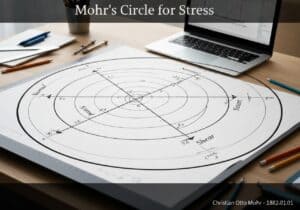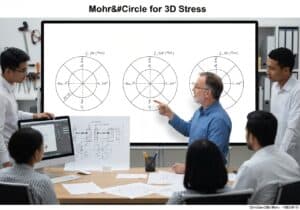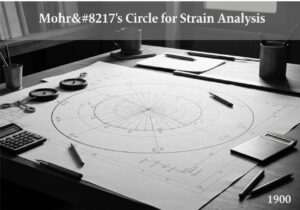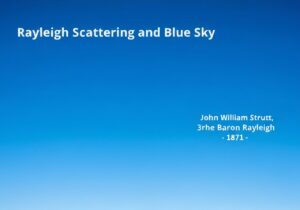The principal stresses, [latex]\sigma_1[/latex] and [latex]\sigma_2[/latex], are the maximum and minimum normal stresses at a point, occurring on planes with zero shear stress. On Mohr’s circle, these correspond to the two points where the circle intersects the horizontal ([latex]\sigma_n[/latex]) axis. The maximum in-plane shear stress, [latex]\tau_{max}[/latex], is equal to the radius of the circle, [latex]R[/latex].
Identifying principal stresses and maximum shear stress is a primary application of Mohr’s circle. The principal stresses are the eigenvalues of the stress tensor and represent the extreme values of normal stress. They are found at the intersections of the circle with the [latex]\sigma_n[/latex] axis, calculated as [latex]\sigma_{1,2} = \sigma_{avg} \pm R[/latex], where [latex]\sigma_{avg}[/latex] is the center of the circle and [latex]R[/latex] is its radius. The planes on which these stresses act are called principal planes, and they are mutually orthogonal. On Mohr’s circle, the angle [latex]2\theta_p[/latex] from the reference state to the principal state can be found using trigonometry: [latex]\tan(2\theta_p) = \frac{2\tau_{xy}}{\sigma_x – \sigma_y}[/latex].
The maximum in-plane shear stress, [latex]\tau_{max}[/latex], corresponds to the highest and lowest points on the circle, with a magnitude equal to the circle’s radius, [latex]R[/latex]. The planes of maximum shear are oriented at 45 degrees to the principal planes. This is visually represented on the circle by a 90-degree rotation from the principal stress points. Understanding these maximum values is critical in engineering design, as material failure, particularly in ductile materials, is often initiated by shear stress. Failure theories, such as the Tresca (Maximum Shear Stress) criterion, directly use this value to predict the onset of yielding.
















